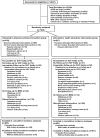Effect of Physical Activity on Frailty: Secondary Analysis of a Randomized Controlled Trial
- PMID: 29310138
- PMCID: PMC5898617
- DOI: 10.7326/M16-2011
Effect of Physical Activity on Frailty: Secondary Analysis of a Randomized Controlled Trial
Abstract
Background: Limited evidence suggests that physical activity may prevent frailty and associated negative outcomes in older adults. Definitive data from large long-term randomized trials are lacking.
Objective: To determine whether a long-term, structured, moderate-intensity physical activity program is associated with a lower risk for frailty and whether frailty status alters the effect of physical activity on the reduction in major mobility disability (MMD) risk.
Design: Multicenter, single-blind, randomized trial.
Setting: 8 centers in the United States.
Participants: 1635 community-dwelling adults, aged 70 to 89 years, with functional limitations.
Intervention: A structured, moderate-intensity physical activity program incorporating aerobic, resistance, and flexibility activities or a health education program consisting of workshops and stretching exercises.
Measurements: Frailty, as defined by the SOF (Study of Osteoporotic Fractures) index, at baseline and 6, 12, and 24 months, and MMD, defined as the inability to walk 400 m, for up to 3.5 years.
Results: Over 24 months of follow-up, the risk for frailty (n = 1623) was not statistically significantly different in the physical activity versus the health education group (adjusted prevalence difference, -0.021 [95% CI, -0.049 to 0.007]). Among the 3 criteria of the SOF index, the physical activity intervention was associated with improvement in the inability to rise from a chair (adjusted prevalence difference, -0.050 [CI, -0.081 to -0.020]). Baseline frailty status did not modify the effect of physical activity on reducing incident MMD (P for interaction = 0.91).
Limitation: Frailty status was neither an entry criterion nor a randomization stratum.
Conclusion: A structured, moderate-intensity physical activity program was not associated with a reduced risk for frailty over 2 years among sedentary, community-dwelling older adults. The beneficial effect of physical activity on the incidence of MMD did not differ between frail and nonfrail participants.
Primary funding source: National Institute on Aging, National Institutes of Health.
Figures


Comment in
-
Frailty as an Outcome in Geriatrics Research: Not Ready for Prime Time?Ann Intern Med. 2018 Mar 6;168(5):361-362. doi: 10.7326/M17-3048. Epub 2018 Jan 9. Ann Intern Med. 2018. PMID: 29310132 Free PMC article. No abstract available.
-
Effect of Physical Activity on Frailty.Ann Intern Med. 2018 Aug 21;169(4):266. doi: 10.7326/L18-0242. Ann Intern Med. 2018. PMID: 30128515 No abstract available.
-
Effect of Physical Activity on Frailty.Ann Intern Med. 2018 Aug 21;169(4):267. doi: 10.7326/L18-0243. Ann Intern Med. 2018. PMID: 30128516 No abstract available.
Summary for patients in
-
Effect of Physical Activity on Frailty.Ann Intern Med. 2018 Mar 6;168(5). doi: 10.7326/P17-9052. Epub 2018 Jan 9. Ann Intern Med. 2018. PMID: 29310139 No abstract available.
References
-
- Chang SF, Lin PL. Frail phenotype and mortality prediction: A systematic review and metaanalysis of prospective cohort studies. Int J Nurs Stud. 2015;52(8):1362–1374. - PubMed
-
- Ensrud KE, Ewing SK, Taylor BC, et al. Comparison of 2 frailty indexes for prediction of falls, disability, fractures, and death in older women. Arch Intern Med. 2008;168(4):382–9. - PubMed
-
- Boyd CM, Xue QL, Simpson CF, Guralnik JM, Fried LP. Frailty, hospitalization, and progression of disability in a cohort of disabled older women. Am J Med. 2005;118(11):1225–31. - PubMed
-
- Bandeen-Roche K, Xue QL, Ferrucci L, et al. Phenotype of frailty: characterization in the women’s health and aging studies. J Gerontol A Biol Sci Med Sci. 2006;61(3):262–6. - PubMed
-
- Woods NF, LaCroix AZ, Gray SL, et al. Frailty: emergence and consequences in women aged 65 and older in the Women’s Health Initiative Observational Study. J Am Geriatr Soc. 2005;53(8):1321–30. - PubMed
Publication types
MeSH terms
Grants and funding
LinkOut - more resources
Full Text Sources
Other Literature Sources
Medical
